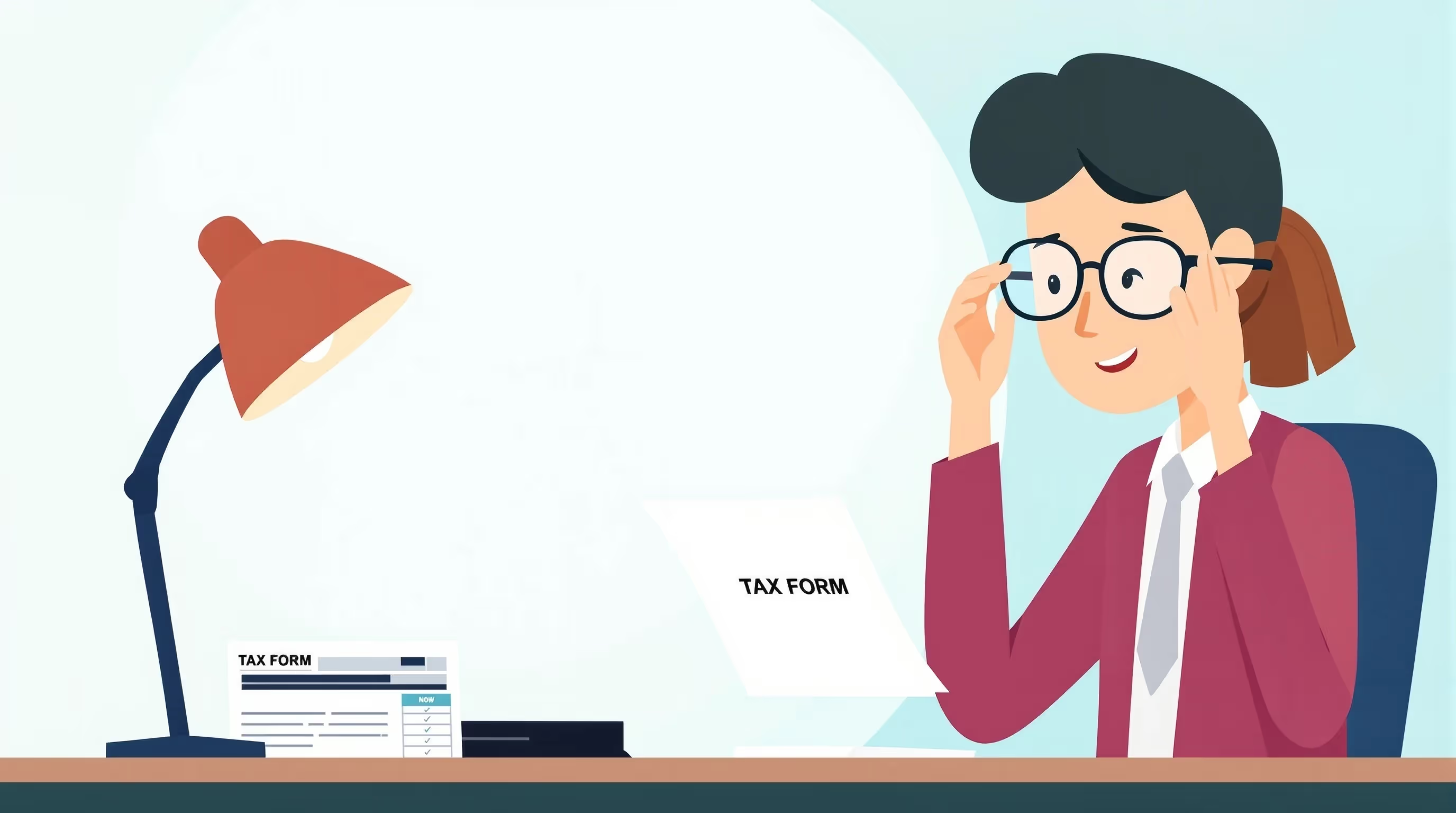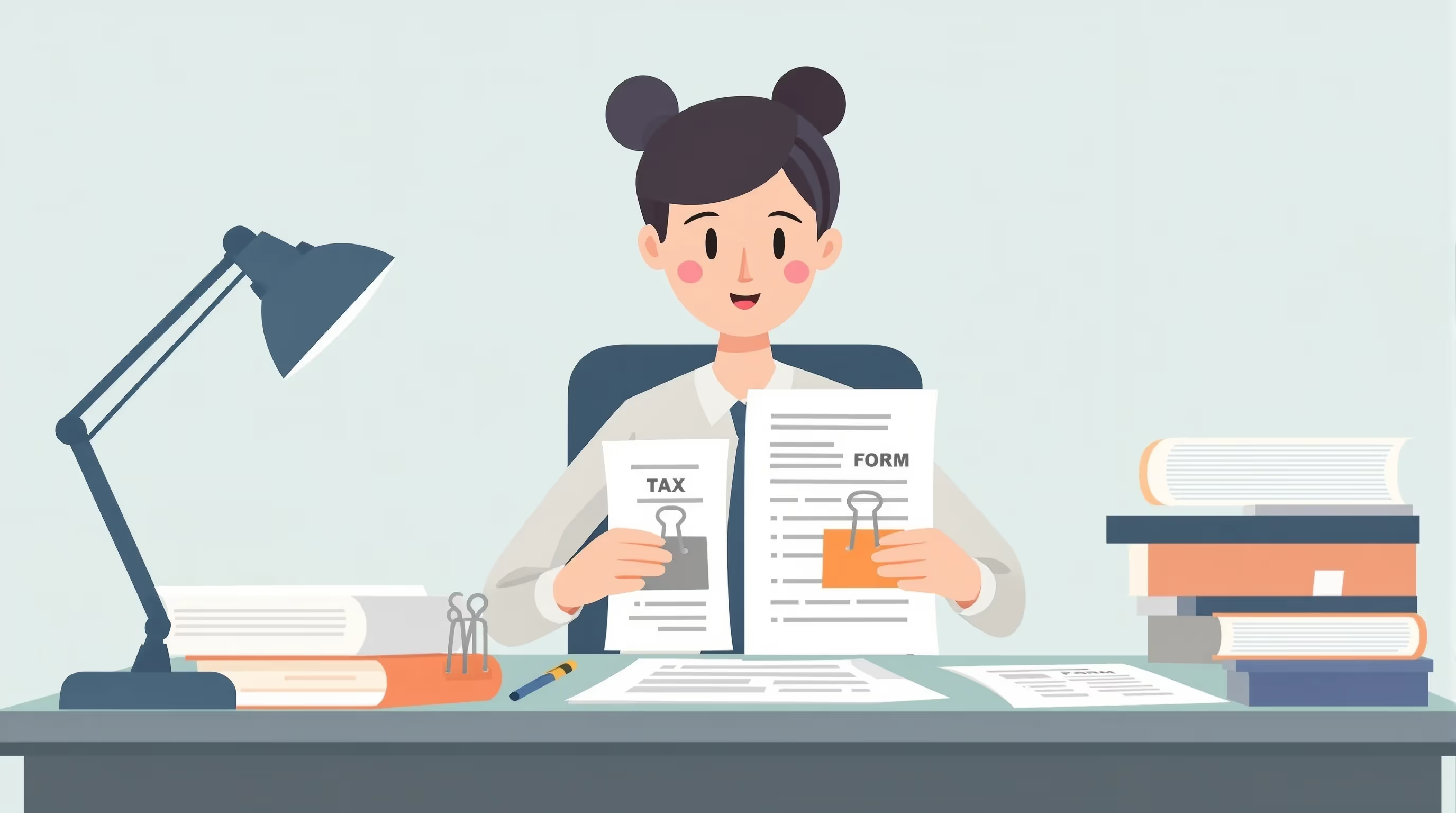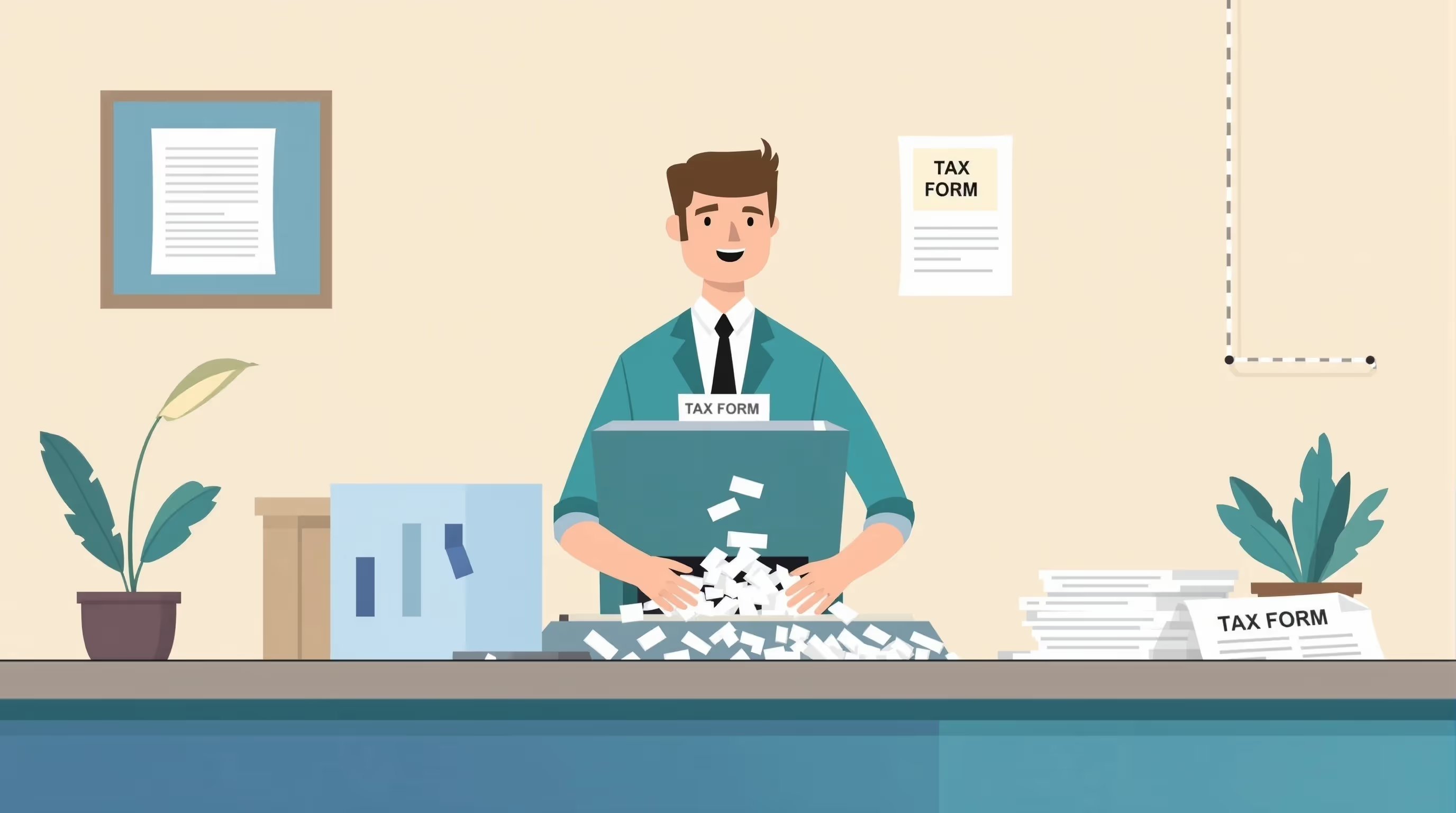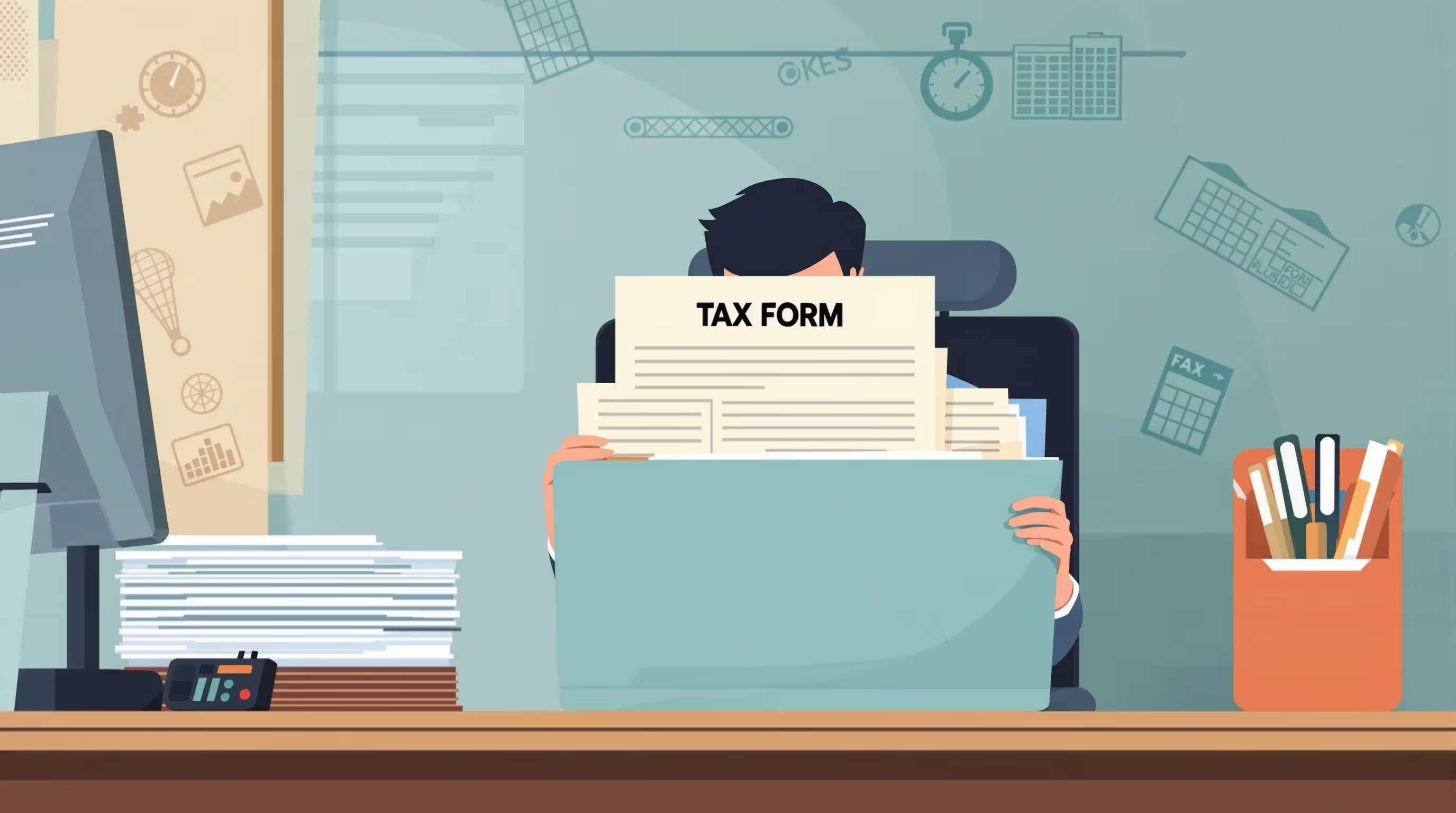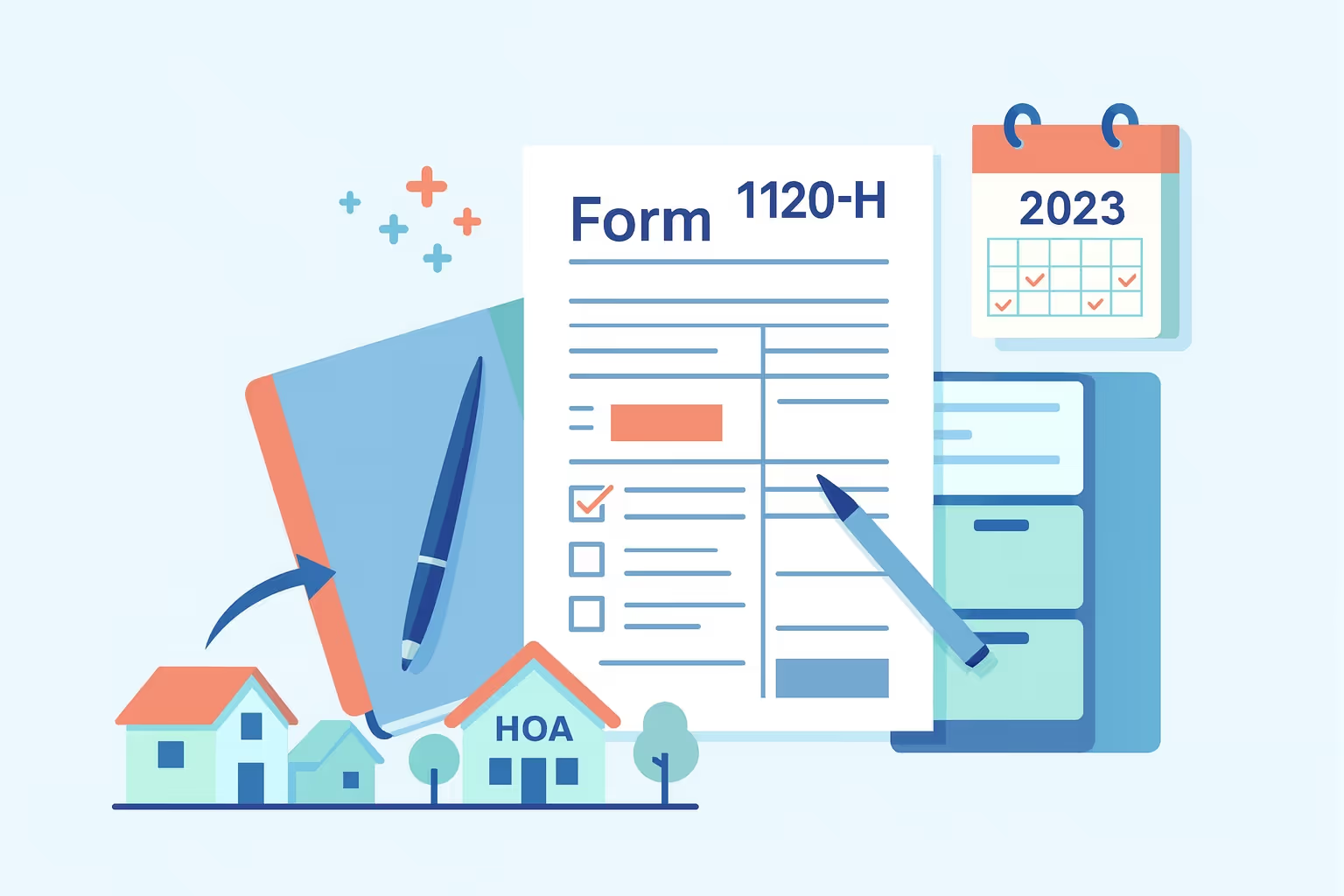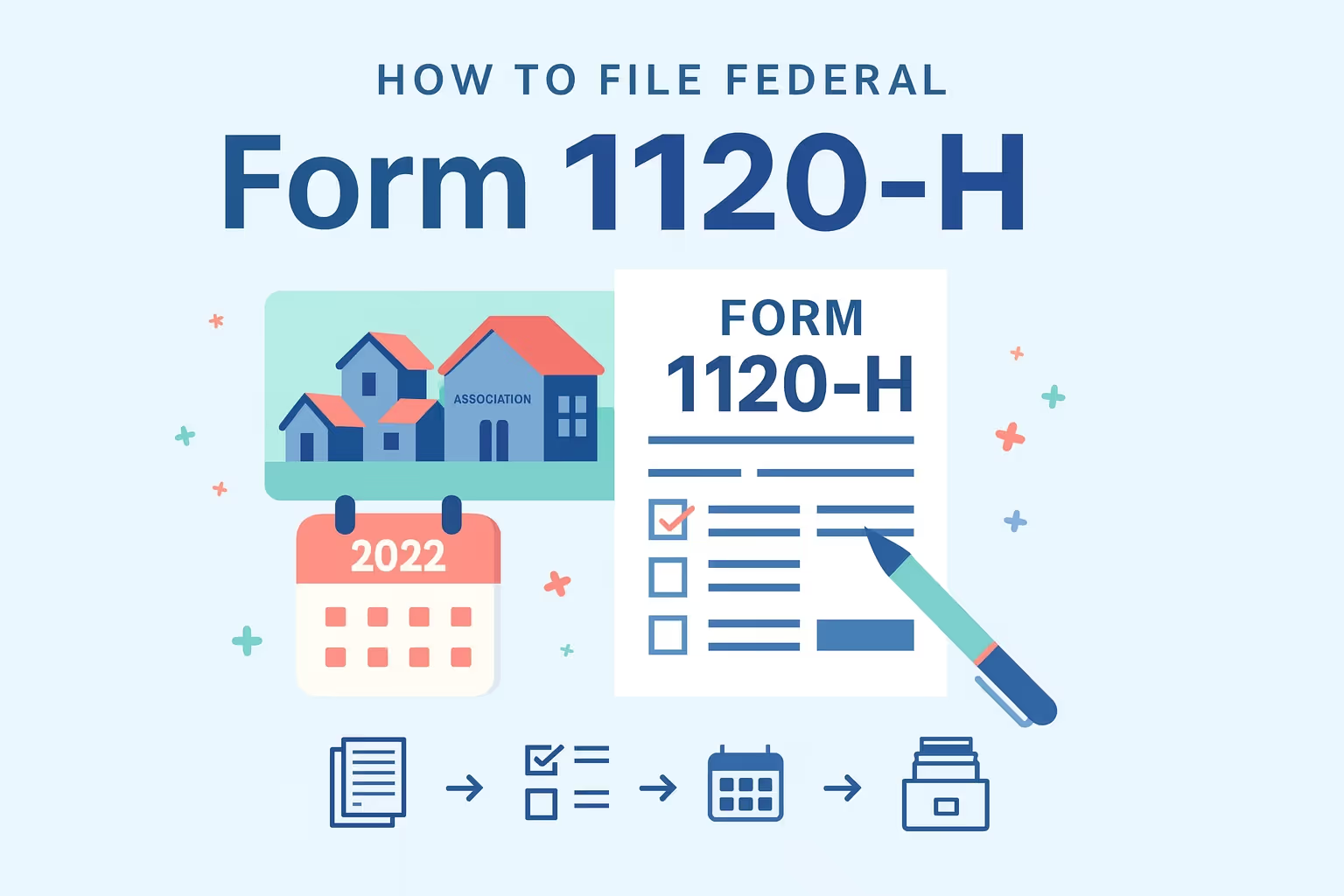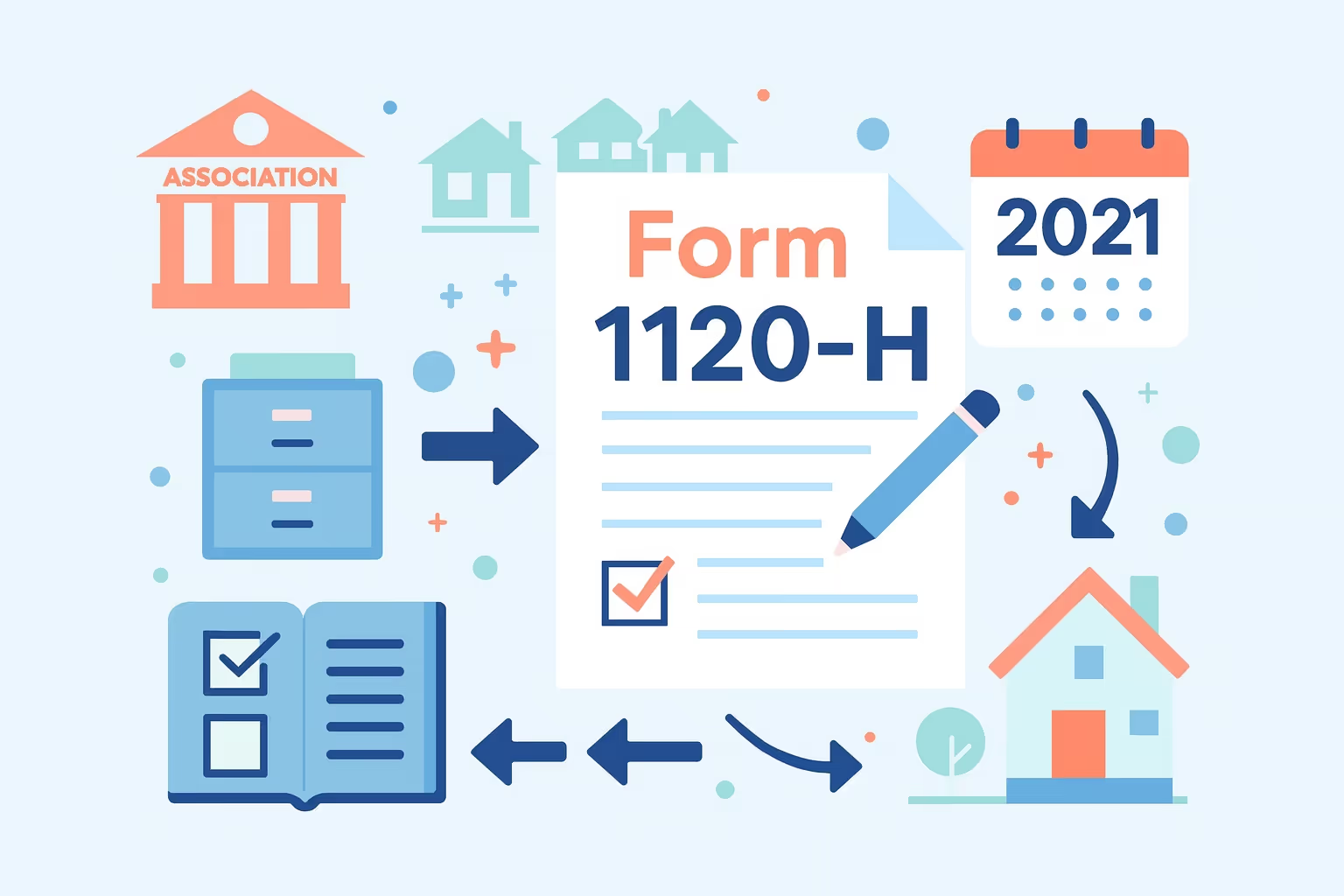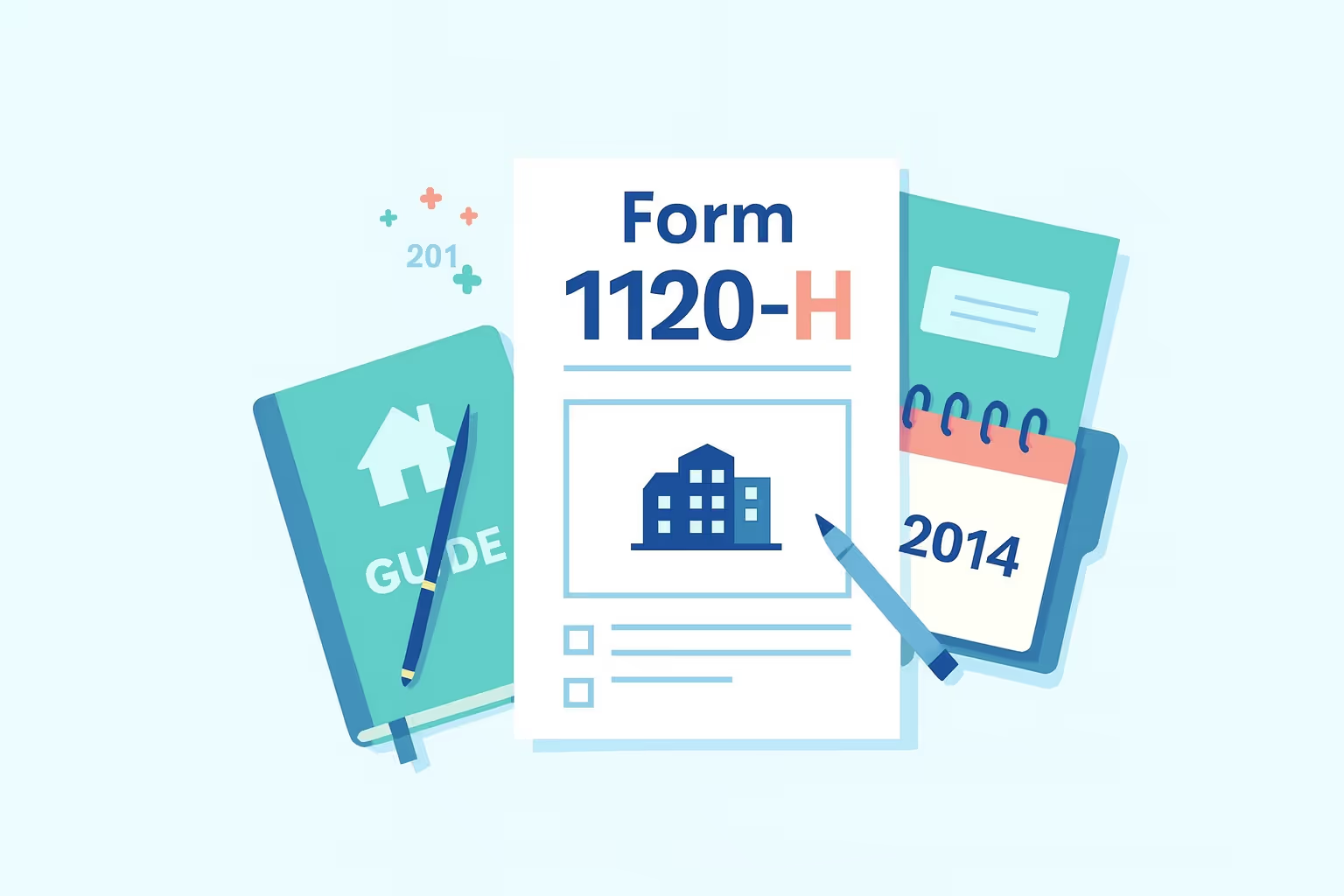How to File Federal Form 1120-H for Tax Year 2020
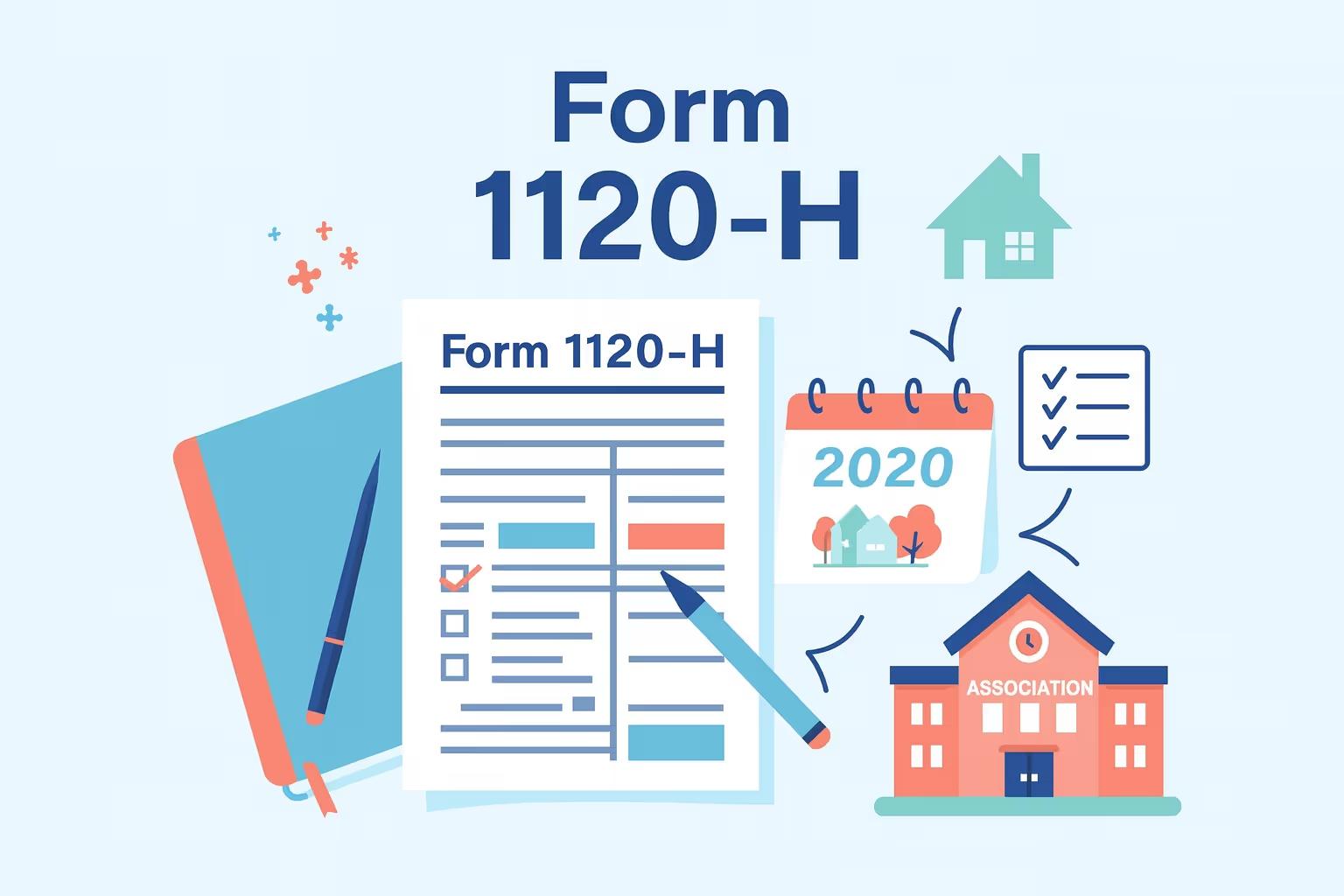
Every year, Homeowners' Associations across the United States face the task of filing their federal income tax return. According to the Community Associations Institute, more than 1.5 million homeowner associations exist nationwide. Yet, many fail to take advantage of the specific tax benefits under the Internal Revenue Code. The result is costly mistakes that increase tax liability, delay refunds, or invite penalties. Federal Form 1120-H for Tax Year 2020 provides a straightforward way to protect your association from these risks.
The advantage of filing this form is clear: associations can exclude exempt function income from gross income, keeping member dues and assessments shielded from unnecessary taxation. Filing as a regular corporation instead can expose associations to higher tax rates and stricter reporting requirements. The savings can be substantial for organizations managing residential units, swimming pools, tennis courts, or shared association property. Missing the chance to file correctly could mean paying thousands more than required.
The process, however, is not as simple as checking a box. Filing Form 1120-H requires that your association meet certain conditions, prepare detailed records, and file by the Internal Revenue Service deadline. Errors such as misreporting income, missing attachments, or paying by the wrong method can result in painful penalties. This guide will walk through each step, highlight common mistakes, and show how Homeowners' Associations can confidently file. Understanding the form and filing on time allows your association to secure valuable tax benefits while avoiding unnecessary costs.
Understanding Federal Form 1120-H for Tax Year 2020
Filing Federal Form 1120-H for Tax Year 2020 begins with understanding the form and who qualifies to use it. Many associations mistakenly assume they must file a traditional corporation income tax return, but this is rarely the most advantageous route. The Internal Revenue Service created Form 1120-H to simplify the process for Homeowners' Associations while providing certain tax benefits.
What is Federal Form 1120-H?
Form 1120-H is a federal income tax return explicitly designed for Homeowners' Associations that meet the Internal Revenue Code Section 528 requirements. This section of the tax law provides an election that allows associations to exclude exempt function income from their association’s gross income. Exempt function income consists of membership dues, fees, and assessments collected from owners to pay for association property or services provided for residential purposes.
When properly filed, the form limits taxable income to only non-exempt function income. This might include investment interest, rental of common areas, or capital gains. The form applies a flat rate of 30 percent on taxable income (32 percent for timeshare associations). This rate usually produces a lower tax liability than filing a regular corporation income tax return.
Who Can File Form 1120-H?
Not every organization that manages property is eligible to file. The Internal Revenue Service restricts the eligibility to file this tax return to Homeowners' Associations that belong to one of the following categories:
- Condominium Management Association: This association is organized to acquire, build, manage, maintain, and care for condominium projects. Substantially all units must be used by individuals for residential purposes.
- Residential Real Estate Management Association: These associations manage subdivisions, developments, or similar residential areas. Their services often include maintaining shared roads, tennis courts, or available swimming pools for property owners.
- Timeshare Association: These organizations manage property used by timeshare owners. Because timeshare arrangements differ from traditional HOAs, they face a slightly higher tax rate of 32 percent.
Comparison 1: Form 1120-H vs. Form 1120
Form 1120-H
- Purpose: Federal income tax return designed specifically for homeowners’ associations.
- Eligibility: Available to condominium associations, residential real estate associations, or timeshare associations that meet IRS qualification tests.
- Tax Treatment: Exempt function income (like dues and assessments) is excluded. Taxable income is subject to a flat 30% rate (32% for timeshare associations).
- Complexity: Simplified filing process with limited schedules.
- Risk of Audit: Lower, provided the association meets all eligibility requirements.
Form 1120
- Purpose: Standard corporate income tax return used by businesses.
- Eligibility: Required for all corporations, including HOAs that fail IRS qualification tests for 1120-H.
- Tax Treatment: All income — including member assessments — is taxed under graduated corporate tax rates (up to 21%).
- Complexity: More detailed, requiring extensive schedules and accounting records.
- Risk of Audit: Higher, due to the broader scope of reporting and fewer exclusions.
Understanding these differences is critical. Filing the wrong tax form may force your association to treat exempt function income as taxable, raising your overall tax liability and exposing members to unnecessary costs.
Key Tax Benefits for Homeowners' Associations
Filing Federal Form 1120-H for Tax Year 2020 offers more than compliance: it delivers certain tax benefits that can make a noticeable financial difference for homeowners' associations. By correctly classifying income and expenses, associations can reduce their tax liability and avoid overpaying the Internal Revenue Service.
Exempt Function Income Explained
Exempt function income consists of membership dues, fees, and assessments collected from property owners for residential purposes. This income is directly tied to services such as maintaining common areas, repairing association property, and managing residential units. Because the Internal Revenue Code recognizes this as non-profit-oriented income, Homeowners’ Associations can exclude exempt function income from their gross income.
For example, if an association collected $120,000 in member assessments and $20,000 in investment income, only the $20,000 would be taxable. The exempt portion is shielded, which is a decisive advantage over filing a standard corporation income tax return.
Certain Tax Benefits of Filing 1120-H
Associations that file Form 1120-H are entitled to several distinct benefits:
- Flat tax rate: The form applies a flat 30 percent rate on taxable income, with timeshare associations subject to 32 percent. This approach removes the complexity of graduated corporate rates and provides predictable tax planning.
- Exclusion of exempt function income: Since exempt function income is not included in the association’s gross income, most HOAs report a far smaller taxable base.
- Specific deduction: A $100 deduction is automatically applied to reduce taxable income before tax is calculated. While small, it reflects the Internal Revenue Service’s recognition that associations operate differently from standard corporations.
Risks of Not Filing
Not filing Form 1120-H or failing to meet the IRS eligibility requirements can be costly. Associations that default to Form 1120 must report all income, including member assessments, as taxable income. This increases taxable income and may lead to higher payments and potential penalties if errors occur.
Missing the filing deadline carries equally harsh consequences. Late returns trigger penalties and interest that grow monthly until the tax is paid. For an association with limited reserves, these penalties can force members to pay principal from their own funds, creating frustration and financial stress. Filing Form 1120-H on time is therefore more than a legal requirement: it safeguards the community's economic health.
Section 3: Step-by-Step Filing Process
Filing Federal Form 1120-H for Tax Year 2020 requires careful preparation and accurate reporting. Each part builds on the last; minor errors can quickly lead to penalties or overpayment. The following steps outline the process so Homeowners' Associations can file confidently and avoid costly mistakes.
Step 1: Determine Eligibility
Before starting the tax form, confirm that your association meets the IRS requirements:
- The 60 percent income test must be met.
At least 60 percent of the association’s gross income should consist of exempt function income, such as membership dues or assessments collected from owners. If non-exempt function income exceeds this threshold, the HOA cannot use Form 1120-H.
- The 90 percent expenditure test is equally important.
At least 90 percent of the association’s expenses must go toward acquiring, building, managing, maintaining, or caring for association property. Expenses that benefit private shareholders do not qualify under this test.
- No private shareholder can profit.
The Internal Revenue Code requires that no part of net earnings benefit private shareholders, except through property ownership or dues rebates.
Example: If an association collects $100,000 in total income, and $65,000 is exempt function income, the ratio is 65 percent. This meets the IRS’s 60 percent threshold and allows the HOA to qualify.
Step 2: Gather Crucial Financial Documents
Having complete and accurate documents is essential. Missing or vague records create reporting errors that delay refunds and may result in audits. Key items include:
- Employer Identification Number (EIN): The IRS requires that all returns include a valid EIN, and associations should ensure that it matches exactly as issued.
- Prior year’s tax return: Comparing the current year to the preceding year helps catch discrepancies and prevent overlooked carryovers.
- Detailed income statements: These records must clearly separate exempt function income from non-exempt function income so the IRS can verify eligibility.
- Investment income and capital gains records: Associations should provide brokerage statements, bank interest records, and details on any property sales.
- Expense records: Each expense should be categorized to show how it relates to association property. This helps demonstrate compliance with the 90 percent expenditure test.
Step 3: Complete the Form Header
The header of Form 1120-H may appear simple, but accuracy here prevents processing delays. Associations must include the correct name, mailing address, EIN, and tax year. They must also check the correct association type—condominium management, residential real estate, or timeshare. Associations should also mark special boxes for amended, name-change, or final returns when applicable.
Step 4: Report Gross Income (Lines 1–8)
Only non-exempt function income should be reported here:
- Dividends and taxable interest: This category includes taxable bank interest, bond interest, and mutual fund dividends. Associations should not include tax-exempt municipal bond interest, which is reported separately.
- Rental income: Income from leasing common areas such as a clubhouse, meeting space, or recreational facility must be reported.
- Capital gains and royalties: Any gain from selling association property is taxable, and supporting schedules such as Schedule D must be attached.
- Other income: Any additional non-exempt function income must be listed, and the association should provide a detailed breakdown in a supporting statement.
Step 5: Calculate Deductions (Lines 9–16)
Associations may claim deductions for expenses directly tied to producing taxable income:
- Salaries and wages: Only wages paid to employees generating taxable income are deductible. For example, an employee who manages a rental property qualifies, but an employee who manages exempt property does not.
- Real estate taxes: Property taxes on income-producing property may be deducted, but taxes on exempt property do not qualify.
- Repairs and depreciation: Repairs for taxable-use property and depreciation claimed through Form 4562 can reduce taxable income.
- Other deductions: Any other qualifying deductions must be itemized and explained in a clear statement so the IRS understands their purpose.
Step 6: Tax Computation and Credits
Once gross income and deductions are reported, associations calculate their taxable income:
- Subtract total deductions from non-exempt gross income to determine net income.
- Apply the $100 specific deduction to reduce taxable income further.
- To compute tax liability, multiply the result by 30 percent (or 32 percent for timeshare associations).
- Apply any available tax credits to reduce the final amount owed. Proper forms and documentation must support these credits.
Step 7: Payments, Refunds, and Overpayments
Associations must calculate payments made during the year, including estimated costs and extensions. The due date for calendar-year associations is April 15, 2021. The difference must be paid if the total tax owed is greater than the payments made. If costs exceed the liability, associations may request a refund or apply the overpayment to the following year.
- Penalty reminder: Late payments are penalized at 0.5 percent per month, and interest accrues until the balance is satisfied.
- Refund speed: Electronic filers often receive refunds within 30 days, while paper filers may wait 8 weeks or longer.
Step 8: Filing Options (E-file vs. Paper)
The IRS strongly encourages electronic filing. Associations that submit 10 or more federal returns annually are required to file electronically.
Comparison 2: E-file vs. Paper Filing
E-File
- Speed: Refunds are typically processed within 30 days.
- Accuracy: Built-in IRS software validation helps reduce errors.
- Cost: Requires IRS-approved software but usually saves time and reduces delays.
- Compliance: Mandatory if filing 10 or more federal returns.
Paper Filing
- Speed: Refunds may take 8 weeks or longer.
- Accuracy: Higher error rate due to manual entry and handling.
- Cost: Mailing and preparation costs make it more expensive overall.
- Compliance: Still allowed for smaller associations filing fewer than 10 returns.
Electronic filing is faster, more accurate, and provides an electronic acknowledgment. Paper filing remains an option, but it is a painfully slow process that increases the chance of IRS rejection or delay.
Common Mistakes and How to Avoid Them
Even associations that qualify for Federal Form 1120-H for Tax Year 2020 often stumble during filing. These errors may appear minor initially, but can quickly result in higher tax liability, processing delays, or IRS penalties. Understanding the most common pitfalls will help your association file correctly and avoid unnecessary costs.
Errors with Eligibility Tests
- Miscalculating gross income percentage: Some associations mistakenly include exempt function and non-exempt income in the wrong categories, causing them to fail the 60 percent test. Always verify that exempt function income consists only of membership dues, fees, and assessments from owners.
- Counting non-qualifying expenses: Expenses unrelated to managing or maintaining association property are sometimes included in the 90 percent test. Associations should review expenditures carefully and exclude costs that do not directly support residential units or common property.
Filing Mistakes
- Missing required schedules: Failing to attach forms such as Schedule D, Form 4562, or Form 4797 when reporting capital gains or depreciation is a standard error. The IRS may reject or delay processing until all schedules are provided.
- Applying the wrong tax rate: Some filers mistakenly apply the 30 percent flat rate when they are a timeshare association, which requires a 32 percent rate. Associations should review their classification before finalizing the return.
Payment and Documentation Issues
- Mailing payments instead of using EFTPS: The IRS requires federal tax payments to be made electronically, yet many associations still send paper checks. This mistake delays payment posting and increases the chance of penalties.
- Forgetting signatures: An unsigned return is considered incomplete. The IRS will return the form, and the association may be marked late even if the original submission was on time.
Special Situations for Homeowners' Associations
Not all Homeowners' Associations file under the same circumstances. Some may have little to no annual income, others may be new organizations, and a few may dissolve. The requirements for Federal Form 1120-H for Tax Year 2020 can differ in these special situations. Knowing how to proceed ensures compliance and avoids unnecessary penalties.
Dormant or Zero-Activity Years
- Filing with minimal or no activity: Even if your association had no income, filing Form 1120-H is often recommended to preserve the Section 528 election. Filing shows the IRS that the association remains in good standing.
- Reporting minor income or expenses: Even if your HOA earned small interest income or had minimal expenses like bank fees, these must still be reported. Entering zeros where appropriate keeps the return accurate.
- Benefits of filing in a dormant year: Filing maintains continuity, avoids potential penalties, and ensures that exempt function income can be excluded in future years without interruption.
Dissolving Associations
- Final return requirements: Dissolved associations must check the “Final Return” box on Form 1120-H. This signals the IRS that the association is ceasing operations and no longer needs to file in future years.
- Reporting distributions and expenses: Any remaining funds and final payments must be reported. Accurate reporting avoids disputes or penalties after dissolution.
New Associations
- First-time filing steps: Newly created associations must obtain an Employer Identification Number (EIN) before filing. Without this number, the IRS will not accept the tax return.
- Organizing financial records: Even in the first year, associations should separate exempt and non-exempt income, document assessments, and track expenditures. This helps ensure the 60 percent and 90 percent tests are satisfied.
- When to seek professional help: A tax professional can guide new associations through their first filing. This is especially valuable if the HOA has multiple revenue sources, capital gains, or questions about eligibility.
When to Seek Professional Help
Filing Federal Form 1120-H for Tax Year 2020 is more straightforward than filing a standard corporation income tax return, but some associations face complications that make professional guidance essential. A qualified tax professional can help avoid missteps and ensure the association receives all available tax benefits.
Situations Requiring a Tax Professional
- Complex income structures: Associations with multiple income streams, such as rental income, investment dividends, and capital gains, may find it challenging to separate exempt function income from taxable income. A professional can ensure each category is reported correctly.
- Failure of IRS qualification tests: If an association cannot meet the 60 percent or 90 percent test, it must file Form 1120 instead of 1120-H. Tax professionals can calculate these tests precisely and confirm the correct filing route.
- Prior IRS correspondence or penalties: Associations that have received IRS notices, penalties, or audit requests should consult a professional. Expert guidance reduces risk and helps resolve issues more quickly.
Benefits of Professional Guidance
- Avoiding errors that increase tax liability: A tax professional understands how to properly apply deductions, classify expenses, and exclude exempt function income from the association’s gross income. This expertise reduces costly mistakes.
- Maximizing available deductions and credits: Professionals know which deductions and credits apply, and how to substantiate them with documentation. This ensures the HOA pays only what is legally required.
- Reducing audit risks: Properly filed forms supported by thorough records lower the chance of IRS scrutiny. If an audit does occur, having a professional familiar with the association’s filing history is invaluable.
FAQs
What is exempt function income on Federal Form 1120-H for Tax Year 2020?
Exempt function income consists of membership dues, assessments, and fees collected from property owners to maintain association property and services for residential purposes. This includes expenses like repairing swimming pools, maintaining tennis courts, or landscaping common areas. The Internal Revenue Service allows Homeowners' Associations to exclude exempt function income from their gross income, significantly lowering taxable income and ensuring that tax benefits are correctly applied.
Can Homeowners' Associations file Form 1120 instead of 1120-H?
Homeowners' Associations can file Form 1120, the standard corporation income tax return. However, doing so usually increases tax liability because the association must report all income, including exempt function income, as taxable. Filing Federal Form 1120-H for Tax Year 2020 generally provides greater advantages, such as the ability to exclude exempt function income, apply the $100 deduction, and benefit from a flat rate tax structure.
How does filing 1120-H affect taxable income for residential units?
Filing Form 1120-H limits taxable income to only non-exempt function income, such as investment interest, capital gains, or rental income from association facilities. Exempt function income from assessments, fees, or dues tied to residential units is excluded. This means that most funds collected from members are shielded from taxation. As a result, homeowners' associations usually pay less federal taxes and can dedicate more resources to property upkeep and services.
What happens if our HOA fails to file the federal income tax return?
Penalties apply if your association misses the due date for filing Federal Form 1120-H for Tax Year 2020. The IRS typically imposes a 5 percent failure-to-file penalty for each month the return is late, up to a maximum of 25 percent. Interest also accrues on any unpaid tax liability starting from the original due date. Filing late can also jeopardize your association’s ability to claim certain tax benefits, making timely filing essential.
Do real estate taxes and membership dues qualify as deductible expenses?
Membership dues paid by homeowners are considered exempt function income, not deductible expenses. Instead, they are excluded from the association’s gross income. Real estate taxes may be deductible if they apply to income-producing property, such as a rental unit or clubhouse. Associations must carefully separate expenses related to exempt activities from those linked to taxable income. Working with a tax professional helps ensure these distinctions are adequately reported to the Internal Revenue Service.






